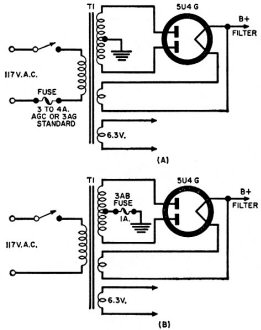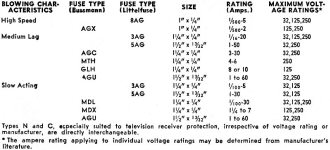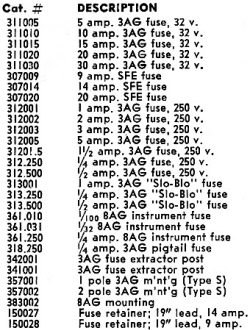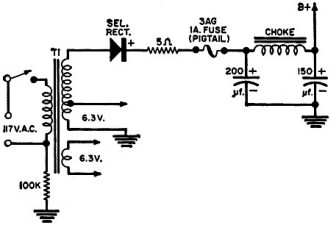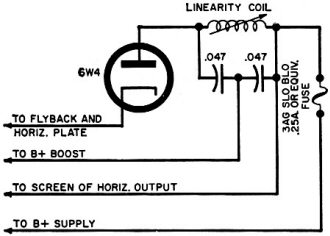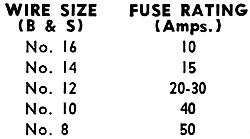Fuses Are Not for Confusion
|
|
Back in the early 1990s I had my first need as a product design engineer to select a fuse type; it was for protecting a downconverter chassis. Having already worked in the electronics and electrical equipment installation and maintenance field for twenty years, I have had to replace many fuses of many different types in many types of assemblies ranging from AC motor controls to microprocessor boards. Slo−Blo, Fast−Blo, Standard−Blo, high voltage and low voltage, high current and low current, glass bodied, plastic bodied, and even metal explosion-proof bodied fuses were in the realm my experience. However, some other engineer had already decided what the appropriate fuse was for the application. I assume each instance had been determined from a selection process based on knowledge of both the device to be protected and the characteristics of the fuses. Not just any fuse will do the job. Sometimes you get lucky and the one used will work so long as the current and voltage ratings are within the normal operational range of the product being protected, but if that was generally the case, there wouldn't be such a large variety of fuse types, n'est−ce pas? This "Fuses Are Not for Confusion" article from a 1960 issue of Popular Electronics magazine is a great primer on the art of fuse selection. Fuses Are Not for Confusion
Wrong replacements cause annoyance - or harm. Know which types to use, when, and how to identify them. In recent years, manufacturers of TV receivers and of fuses as well have done much to alleviate a set of common complaints made by set owners and service technicians. "It's that fuse again," is heard less often than in the past. So is the wail of woe over a burned-out part that was not adequately protected. Special requirements have been analyzed and met. New fuses and fuse holders have been developed. However, one ominous factor remains to becloud an otherwise clearing fuse picture - correct fuse replacement. An undo-it-yourself set owner - sometime even a service technician - doesn't happen to have a satisfactory replacement for a blown fuse or cannot identify it properly because the brand he happens to have on hand uses a method of coding that differs from that of the original. The replacement used is one thought to be a reasonably acceptable equivalent. The result may be annoying and unnecessary repeated fuse failure or the burn-out of an expensive component while the fuse remains intact. Sometimes, on the other hand, a replacement with slightly different characteristics is desirable. In any case, the operator should know what he is doing. This means he must know something about fuses and their applications. Blowing Speed The speed with which a fuse blows is important. Broadly, there are three general categories, the quick-acting, medium-lag, and slow-acting (or "Slo-Blo," as Littelfuse calls these types). Actually there are more shades of difference than these three types would indicate. High-speed instrument fuses, like those used to protect meter movements, generally act faster than the more commonly encountered fast-acting types. They are used because some types of instantaneous overloads could damage a meter. Types N and C, especially suited to television receiver protection, irrespective of voltage rating or manufacturer, are directly interchangeable. * The ampere rating applying to individual voltage ratings may be determined from manufacturer's literature. Medium-lag fuses are the most popular, being widely used in aircraft applications, amplifiers, car radios, TV receivers, and other equipment. Ac-cording to brand, these are found in the AGC types (Bussmann) and the 3AG or 5AG types (Littelfuse). Slow-blowing fuses are most useful where harmless transient currents or voltage surges are likely to occur that would ordinarily cause quicker acting fuses to blow unnecessarily. Most fuses, whatever delay they may show under partial overload, will blow rather quickly under heavy overload. Slow-blowing types often find specific applications in TV receivers. The transient surges caused by the action of certain LG networks in the horizontal section of a TV set might cause even a medium-lag fuse to open unnecessarily. The inductances used in many TV circuits (yokes, flyback transformers, peaking coils, others) often create reverse e.m.f.'s for short periods during set warm-up that may double the current drain in a circuit. Table 1 - Common TV and other fuses in the lines of two leading manufacturers. Note that code designations assigned to various fuse types relate to such differences as physical size and blowing characteristics, but not to current rating. A common example of apparent fuse unreliability occurs in the horizontal output stage. Low drive voltage from the horizontal oscillator to the grid of the output tube, especially during warm-up, may permit the latter tube to overload. Voltage Ratings A frequently asked question is, "What does the fuse's voltage rating mean?" Some sets come from the factory with 125-volt fuses installed. Others may use fuses with a maximum rating of 250 volts. Furthermore, the latter may appear in 500-volt circuits. Does the excess voltage make the fuse blow? Essentially, fuses respond to changes in current without respect to the applied voltage, within certain limits. The maximum voltage rating, according to Litteltuse, is that voltage up to which a fuse, when subjected to a current overload (defined as a 10,000-ampere d.c. short circuit), will interrupt safely, without shattering or burning up. The most severe short likely to occur, say, in a TV receiver will produce a current that is only a small fraction of this test rating. Thus fuses rated at 125 or 250 volts can safely be used at much higher voltages. However current ratings must be considered very carefully, taking into account the normal current range likely to be found in the protected circuit and the possible magnitude of harmful overloads. Fatigue Occasionally a technician wonders why a fuse of any type may, for no reason that can be found, fail during operation. He may say facetiously that the fuse just got tired. He may also be correct. In circuits where a constantly interrupted current is flowing through the fuse (vibrator applications, TV horizontal sections, frequency choppers, high-current multivibrators, and the like), such cycling may produce constant expansion and contraction of the fuse element, eventually wearing out this slender, metal strand. This "cyclic fatigue" is just one of many problems confronting a fuse manufacturer endeavoring to supply a reliable product to users. The slow-blowing fuses usually stand up better under cyclic fatigue. Interchangeability One of the problems likely to confuse a technician attempting replacement is the fact that different manufacturers do not code identical or similar fuses in the same way. Table 1 is a handy cross-listing of fuses manufactured by Littelfuse and Bussmann. The boxes in which fuses by the latter manufacturer are packed usually carry cross-identification, although the fuses themselves are not so marked. For example, a pack of Bussmann AGC fuses may carry such information as "formerly called 3AG." For some similar types, there may be slight differences in certain characteristics between one manufacturer and another. While these do not usually affect use much, it is a good idea to learn what they are and what effect they might have in specific applications. Some TV Applications The problem of fuse failure and replacement are of above-average concern in the case of TV receivers, where more than one fuse is likely to be used, where there may be conflicts between over-all and single-section protection, and where the fuses used on a single set may be quite different from each other. A brief examination of common configurations will help show how and where fusing is provided and help in choosing replacements to meet special problems. The partial schematic of Fig. 1A is of a commonly encountered full-wave rectifier circuit. The fuse, in the primary lead of the transformer, gives over-all protection. A disadvantage, if no other fusing is used, lies in the fact that it takes a rather healthy overload to pop the unit. Thus, if no other protection is used, excess current due to a short in a particular circuit may be enough to cause circuit damage but under the amount required to blow the fuse. An advantage is that the expensive power transformer is fully safeguarded. Fig. 2 - Half-wave rectifier supply, fused in d.c. line going to Filter. Fig. 3 - Separate fusing for "B+" supply in TV's horizontal-sweep section.
Table 3 - Ratings of fuses generally used with popular sizes of copper wire. Suppose that the envelope on a rectifier tube should crack. When it does - and every technician has probably seen this happen several times-the filament of a heavy-duty rectifier like the 5U4 may, in the process of melting as it is exposed to air, form a dead short across the 5-volt winding. This could cook a transformer to death. Standard cartridge fuses, rated at a few amperes, are used here. An alternate method of fusing the low-voltage section is shown in Fig. 1B. Here the center-tap on the transformer's high-voltage secondary is fused to ground or "B-." The transformer is protected except in the case of filament-circuit overloads. Since the receiver's many tubes consume quite a bit of filament power in relation to total drain, and current for the filaments does not pass through the fused winding, the current rating of the fuse is substantially reduced. The type 3AB shown is a special, arc-quenching variety often found here. It prevents element flashing, a condition related to the inductance of the transformer. The fuse is a medium-lag type. Fig. 2 shows a common half-wave rectifier using a semiconductor. Sometimes a voltage doubler is used without the transformer. Here a standard pigtail fuse is likely to be found wired into the circuit, but it will be the slow-blowing type too. A surge resistor is necessary to protect the rectifier from the heavy initial surges that would otherwise charge the filter capacitors. Because of these surges, a faster acting fuse might open needlessly. Fig. 3 shows the damper portion of a horizontal-output and high-voltage circuit. Again a slow-acting fuse, but at a reduced current rating, is used. Although the location of the fuse in the horizontal-output circuit may vary, the fuse characteristics are likely to remain the same. Many recently made TV receivers use other protective devices, such as resettable, thermal-overload cut-outs, fusible resistors, and thermistors, instead of fuses. These do not act rapidly, as a rule. Where fuses are used instead, they correspondingly tend to be slow-blowing. Radios and amplifiers usually have medium-acting fuses. Instruments and aircraft equipment tend to use fast-acting fuses, although many aircraft applications call for medium-speed types. Bayonet-type fuses, becoming increasingly popular, were originally designed for the TV industry. These are made in different sizes depending on current rating, as are the corresponding fuse holders. Thus only the right fuse can be inserted and locked into the fuse holder. These type C and N fuses are made by both leading manufacturers, but the two brands may be interchanged. If your fuse kit happens to be short of some types when you need them, you might check your supply against the list of most frequently used types for service dealers and maintenance engineers in Table 2. Some common holders and mountings are listed as well. Also helpful is Table 3, which is a short list of fuse sizes generally used to protect insulated copper wiring of various sizes. Just one more thought before closing. Fuses are used for good reasons - protection and safety, both to equipment and personnel. This good purpose should not be thrown away with a thoughtless or indifferent replacement.
Posted June 2, 2023 |
|

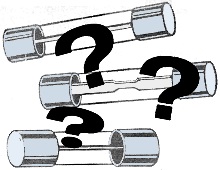 By George D. Philpott
By George D. Philpott 